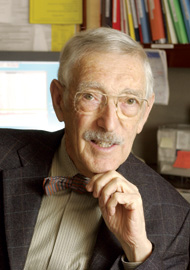On an otherwise ordinary day in 1964,Bruce Ames picked up a box of potato chips and read the list of ingredients. A biochemist at the National Institutes of Health (NIH) in Bethesda, Maryland, Ames spent his days studying mutations in strains of Salmonella, so it wasn’t unusual that he began to wonder if any of the preservatives or chemicals on that long list of ingredients might mutate DNA. Ames decided to use his Salmonella to try to detect genetic damage caused by chemicals. “I figured the world needed some quick, easy test to detect mutagens,” says Ames.
Ames had hundreds of strains of S. typhimuriumwith mutations in the genes required to produce histidine, a standard amino acid for making proteins. These strains could not grow without the addition of histidine. When millions of bacteria were placed in media lacking the amino acid, however, a few would spontaneously mutate, produce histidine again, and survive as a colony. Ames figured if he added a chemical, such as a potato-chip preservative, to the Salmonella strains, and the chemical increased the number of surviving colonies, it was a mutagen.
Ames began tinkering with the test as a hobby. Then, in 1967, when he moved to the University of California, Berkeley, he got some undergraduates to help him develop the assay further. They added rat liver homogenate to theSalmonella as an approximation of mammalian metabolism, which activates many chemicals whose mutagenic action couldn’t be detected by the bacteria alone, and the “Ames test” was born—a simple, inexpensive method for detecting DNA mutagens. Ames immediately put the assay to work: he tested 174 suspected cancer-causing chemicals for the ability to mutate DNA, using a range of concentrations up to the level toxic to the bacteria—and a whopping 90 percent of them were mutagens. It was some of the first evidence that carcinogens mutate DNA.
“Like a lot of hobbies, it slowly took over my life,” says Ames. Over the years, he grew and gave away thousands of samples of the bacteria to other laboratories, and today the Ames test is still used in academic and industrial laboratories worldwide.
His work on mutagens subsequently drew Ames’s interest to cancer prevention, then age-related diseases, then nutrition. A recipient of the National Medal of Science from President Bill Clinton, Ames has published more than 550 papers and is one of the most-cited scientists across all fields.
Here, Ames takes us on a whirlwind tour of his career, from studies of hair dye and children’s pajamas to the defense of pesticide use and vitamins…..







